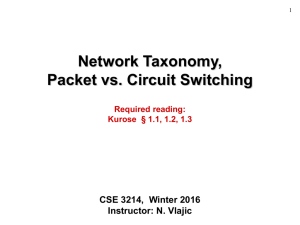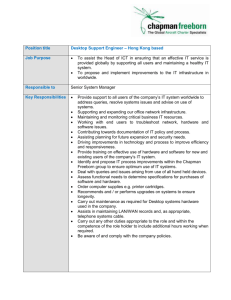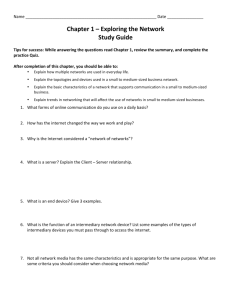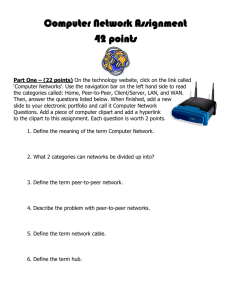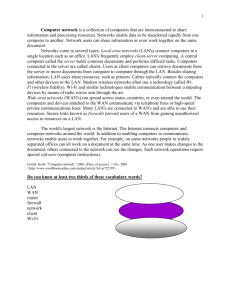Computer Networks I-Chapter 1 - Rahul's
advertisement
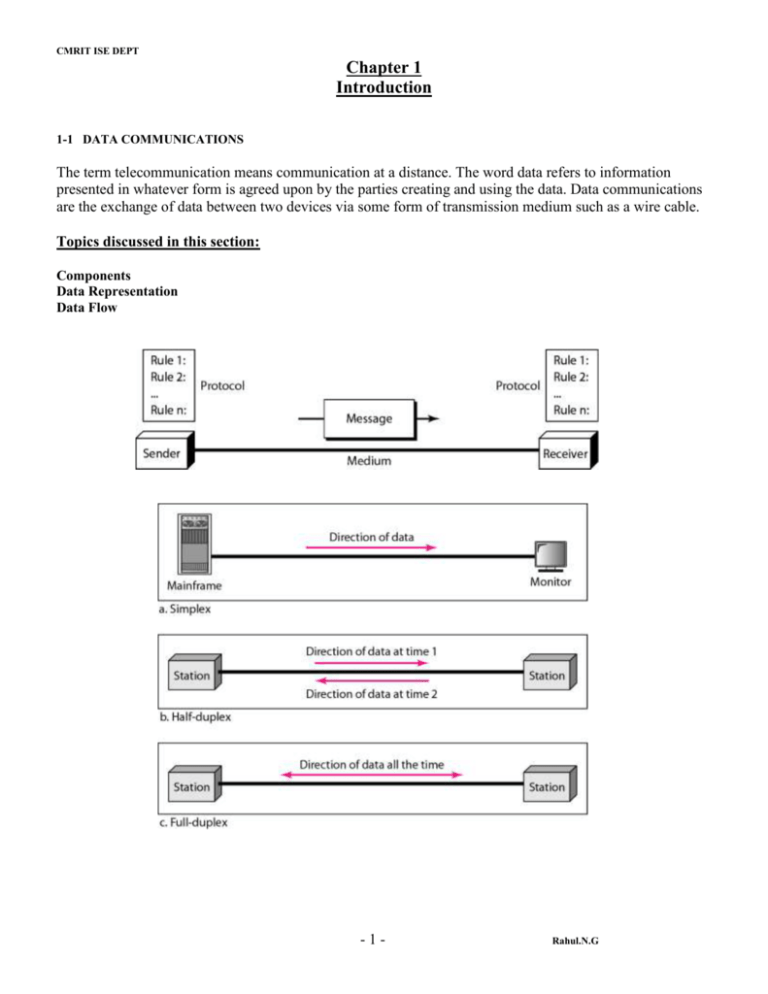
CMRIT ISE DEPT Chapter 1 Introduction 1-1 DATA COMMUNICATIONS The term telecommunication means communication at a distance. The word data refers to information presented in whatever form is agreed upon by the parties creating and using the data. Data communications are the exchange of data between two devices via some form of transmission medium such as a wire cable. Topics discussed in this section: Components Data Representation Data Flow -1- Rahul.N.G CMRIT ISE DEPT 1-2 NETWORKS A network is a set of devices (often referred to as nodes) connected by communication links. A node can be a computer, printer, or any other device capable of sending and/or receiving data generated by other nodes on the network. Topics discussed in this section: Distributed Processing Network Criteria Physical Structures Network Models Categories of Networks Interconnection of Networks: Internetwork Distributed Processing A Network is a set of devices/nodes connected by communication links, each device capable of sending or receiving data generated by other nodes. Most networks use Distributed Processing, in which the task is divided among multiple computers Network Criteria The most important criteria are Performance, Reliability and Security Performance: Is often evaluated by two networking metrics, Throughput and delay. Performance depends on number of factors like transit time (time taken for a msg to travel from one device to another), no. of users, type of transmission medium, efficiency of hardware and software. Reliability: It is the accuracy of delivery, also measured by frequency of failure Security: Protecting data from unauthorized access and implementing policies and procedures for recovery. Physical Structures- Types of connections A network is a set of communication devices connected by media links. . The Possible types of connections are Point-to-Point and Multipoint In a point-to-point connection, two and only two devices are connected by a dedicated link . The entire capacity of the link is reserved for transmission between the two devices. -2- Rahul.N.G CMRIT ISE DEPT The links can be of microwave or satellite or a cable connecting the two ends. Ex: Changing television channels by remote control. In a multipoint connection, three or more devices share a link. Ex: LAN Types of connections: point-to-point and multipoint Physical Structures- Physical Topology Topology refers to the physical or logical arrangement of a network. i.e two or more devices connect to a link, two or more links form a topology. Four basic topologies are: mesh, star, bus and ring topology. In a Mesh topology, every device has a dedicated point-to-point link to every other device A mesh network with n nodes need n(n-1) physical links. Or n(n-1)/2 duplex links. To accommodate the links, every device on the mesh must have (n-1) I/O ports. -3- Rahul.N.G CMRIT ISE DEPT A fully connected mesh topology (five devices) Physical Structures- Physical Topology Advantages of Mesh Topology: Use of dedicated links eliminates traffic problems that can occur with shared links. MT is Robust, If one link becomes unusable, it does not incapacitate the entire system. Enables Privacy or security, message travels along a dedicated line and only intended recipient sees it. Point-to-point links make fault identification easy. Traffic can be routed to avoid links with suspected problems. Disadvantages of Mesh topology: Installation and reconnection are difficult, b’coz every device must be connected to every other device. Sheer bulk of wiring require more accommodation space. The hardware required to connect each link(I/O Ports and cable) can be expensive. For these reasons MT is implemented as a backbone connecting the main computers of a hybrid network. Ex: Connection of telephone regional offices. In a Star topology, each device has a dedicated point-to-point link only to a central controller, usually called a hub. -4- Rahul.N.G CMRIT ISE DEPT The controller acts as an exchange: If one device wants to send data to another, it sends data to the controller, which then relays to the other device. Therefore no direct traffic between devices. A star topology connecting four stations Advantages of STAR Topology Less Expensive, each device needs only one port and one link. Easy to install and reconfigure. Less cabling & additions, moves and deletions involve only one connection Is robust: If one link fails only that is affected, others remain active. As long as hub is working, it can be used to monitor link problems. Disadvantages of STAR Topology: Dependency of the whole topology on one single point. If the hub goes down, the whole system is dead. Although a STAR requires less cabling than a mesh, it requires more cabling than some other topologies. Ex: High-speed LAN’s. Bus Topology is Multipoint. One Cable links all devices in a network. Nodes are connected to the bus cable by drop lines and taps. There is a limit on the number of taps a bus can support and the distance between the taps. As a signal travels along the backbone, some of its energy is transformed into heat, thereby weakening the signal as it travels farther and farther. -5- Rahul.N.G CMRIT ISE DEPT Advantages of Bus Topology Ease of installation. Uses less cabling than Mesh or Star topologies. Disadvantages of Bus Topology Difficult reconnection and fault isolation Difficult to add new devices as it may require modification or replacement of the backbone. A fault in the bus cable stops all transmission. The damaged area reflects signals back in the originating direction, creating noise in both directions. Ex: Ethernet LAN’s In a Ring Topology each device has a dedicated point-to-point connection with only the two devices on either side of it. A signal is passed along the ring in one direction, from device to device, until it reaches its destination. Each device in the ring incorporates a repeater when a device receives a signal intended for another device, the repeater regenerates the bits and passes them along. Advantages of Ring Topology Relatively easy to install and reconfigure. Fault isolation is simplified, If one device does not receive a signal within a specified period, it can issue an alarm, the alarm alerts the network operator to the problem location. Disadvantages -6- Rahul.N.G CMRIT ISE DEPT Unidirectional traffic can be a disadvantage, a break in the ring can disable the entire network. This can be solved by using a dual ring or a switch closing the break. Ring topology was prevalent when IBM introduced LAN Token Ring. High-speed LAN’s made this topology less popular A hybrid topology: a star backbone with three bus networks Network Models The two best known models are the OSI model and the Internet Model. OSI Model defines a seven layer network. Internet model defines a five layer network. Categories of Networks A network can be categorized as a local area network (LAN), a metropolitan-area network (MAN), or a wide area network (WAN). The networks are determined by their size LAN covers an area less than 2 miles. A WAN can be worldwide. Networks of size in between are referred to as MAN and span tens of miles. Ex. Telephone network, or cable TV network LAN is privately owned and links the devices in a single office, building or campus. LAN’s are designed to allow resources to be shared between personal computers. The resources to be shared can include H/W (eg. Printer) , S/W (eg. An application program) or data. -7- Rahul.N.G CMRIT ISE DEPT Ex: Client-Server Applications, Here size of the LAN may be determined by Licensing restrictions ( No. of users per software/ no. of users allowed to access OS) LAN’s are distinguished from other networks by Transmission media and Topology Most common LAN topologies are bus, ring and Star LAN speeds are normally 100 or 1000 Mbps LAN A WAN is a data communication system spanning states, countries, or the whole world. A WAN can be a switched WAN or a Point-to-point WAN Switched WAN connects the end systems, which comprises of a router that connects to another LAN or WAN (Ex: ATM Networks) Point-to-point WAN is a leased line from a telephone or a cable TV provider that connects a home computer or small LAN to an ISP -8- Rahul.N.G CMRIT ISE DEPT Interconnection of Networks An internet is a network of networks or is a collection of many separate networks. As an example, consider an organization that has two offices, one on the east with a Star topology LAN and the other on the west with a Bus topology LAN. A switched WAN is used as a backbone WAN for connecting these LAN’s to the president’s computer. Three point-to-point WAN’s are required to connect the LAN’s to the switched WAN. These point-to-point WAN’s can be a high speed DSL line or a cable modem line. PLEASE REFER TO THE DIAGRAM OF HETEROGENEOUS NETWORK FROM THE SOFTCOPY OR THE TEXT - SOFTCOPY SLIDE 33 FIG. 1.12 THE INTERNET The Internet has revolutionized many aspects of our daily lives. It has affected the way we do business as well as the way we spend our leisure time. The Internet is a communication system that has brought a wealth of information to our fingertips and organized it for our use. Brief History In 1960’s The Advanced Research Projects Agency (ARPA) in the Department of Defense (DoD) showed interest in finding a way to connect computers to share research findings. In 1967, ARPA presented its ideas for ARPANET. The idea was that each host computer would be attached to a specialized computer, called IMP(Interface Message Processor). The IMP’s in turn would be connected to one another. By 1969 ARPANET was a reality. Software called the Network Control Protocol (NCP) provided communication between the hosts. In 1973, TCP/IP - the protocol suite for the Internet was outlined. IP responsible for routing TCP responsible for higher level functions such as segmentation, reassembly and error detection The Internet Today Most end users who want Internet connection use the services of ISPs (Internet Service Providers) There are local, regional, national, and international Internet service providers (ISPs). At the top of the hierarchy are the International ISP’s that connect nations. National ISP’s are backbone networks created and maintained by specialized companies. -9Rahul.N.G CMRIT ISE DEPT These backbone networks are connected by complex switching stations called NAPs (Network Access Points) Regional ISPs are smaller ISPs that are connected to one or more national ISPs. Local ISPs provide direct service to end users. The local ISPs can be connected to regional ISPs or directly to National ISPs Each level of hierarchy differ in terms of Data rate. PROTOCOLS AND STANDARDS In this section, we define two widely used terms: protocols and standards. First, we define protocol, which is synonymous with rule. Then we discuss standards, which are agreed-upon rules. A protocol is a set of rules that governs data communication; The key elements of a protocol are syntax, semantics, and timing. Syntax: Refers to the structure or format of data. Ex: A simple protocol might expect first 8 bits to be address of sender, next 8 bits to be address of receiver and the rest the message. Semantics: Refers to the meaning of each section of bits. Ex: Address identify the route to be taken or the final destination Timing: Refers to two things, When data should be sent and how fast they can be sent. Ex: Sender produces data at 100Mbps, Receiver processes data at 1Mbps, the transmission channel gets overloaded and data will be lost. - 10 - Rahul.N.G CMRIT ISE DEPT Standards are necessary to ensure that products from different manufacturers can work together as expected. Data communications standards fall into two categories de facto (Meaning “by fact” or “by convention”). Those standards have not approved by an organized body but have been adopted as standards through wide spread use. de jure (Meaning “by law” or “by regulation”). Those standards have been legislated by an recognized body. Standards Organizations The ISO, ITU-T, ANSI, IEEE, and EIA are some of the organizations involved in standards creation. Standards committees are procedural bodies and by nature slow-moving. Forums are special-interest groups that quickly evaluate and standardize new technologies. All communications technology is subject to regulation by government agencies as FCC (Federal Communications Commission) Internet Standards An Internet Standard is a thoroughly tested specification that is adhered to by those who work with Internet. There is a procedure by which a specification attains Internet Standard. It begins with an Internet draft , a working document with no official status, Upon recommendation from Internet authorities a draft may be published as a RFC (Request for Comment). Each RFC is edited, assigned a number and made available to interested parties. RFCs are then categorized according to their requirement level - 11 - Rahul.N.G



